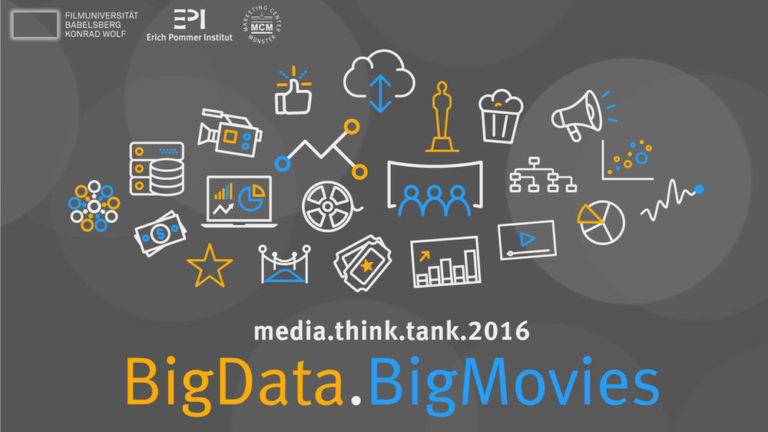Big data – the recipe for movie success?

Under the title “BigData.BigMovies. How algorithms transform the film and TV industries“, the Erich Pommer Institute and the Filmuniversitat Babelsberg Konrad Wolf organised a two day event bringing together science and industry. Mirona, our marketing lead, and Johnny, Gruvi’s lead developer, attended the event. Below you can read their report on some of the most interesting conclusions of recent research on movies big data and how these are implemented to support the film and TV industries.
Science Day
The first day of the event focused on recently published research by a series of academics from around the world. They revealed some very interesting insights regarding both how producers and distributors can affect input factors and how data can help influence decision making for and after a film/ TV series premiers.
We first heard from Allegre Hadid on how social media is changing marketing. The conclusions she presented are the work of a research group which looked at how various factors can be leveraged to market movies. Their findings are related particularly to star power. They distinguish between three types: award star power, market star power, and media star power, all of them having similar effects on a film’s marketing. They are also greater in importance with uncertainty- before the film has actually premiered and stars are the only elements the audience has information about. A suggestion for the near future is to cast stars (actors and directors) based on their media popularity, as this seems to have a bigger impact on short term box office. The study discovered, however, that star power is constantly fading and it predicts that it will become irrelevant by as early as 2024.
The group also researched the effect of reviews, comparing users to critics. They discovered that it is still the critics that influence audiences more to actually watch a movie.
Expert and user reviews were also the focus on the next study presented by Richard Gretz (“How Critical Are Expert Reviews In the Brave New World of Electronic Word of Mouth?”). The study correlated box office revenue with the number of user reviews. This paper also concluded that critics matter more in terms of predicting box office. There could be a difference between a wide release and a platform release, in the sense that platform releases could be subject to bigger influence by the user reviews. However, when there is a big divide between the appreciation of critics and that of the audience, the public tends to trust the audience opinion more. This echoes the recent case of “Suicide Squad”.

The next presentation, of the paper “Super-hero or super-saturation– movie product placement and advertising sales effects”, was presented by Raoul Kubler. The hypothesis of the study was that an increase in the amount of product placement causes a decrease of its efficiency. This was proven to be correct, with the researchers advising to instead introduce product placement in the marketing mix. An example of this method, connecting marketing for a product with a film, is the tie- in between James Bond and BMW. This study also measured the effects of product placement of various intensities, concluding that mid-level product placement benefited most the brand being advertised.
There were many other interesting insights from other papers present during this day. One of those was that a third of the movie consumers form their preferences based on abstract criteria (while two thirds of them rely on product attributes such as casting or a genre). This was one of the findings of a research paper titled “Understanding movie preferences from big data”. The researchers built for this paper an algorithm which is more effective in predicting users preferences then the winner of the Netflix algorithm Prize.
When it comes to evaluating the movie, a study from Bocconi University shows that critics ratings are the only ones efficient in influencing the public evaluation of a movie. They are considerably more powerful than Oscar nominations or the box office on the opening weekend.
Another very interesting study look at how effective are previews in determining purchase decisions on VOD platforms (“The choice and effects of movie previews in video on demand movie services”- Yong Liu, University of Arizona). The paper revealed that while 40% of consumers watch movie previews en VoD services, only around 20% of them watch the preview of the movie they end up seeing. The main questions were how much of a preview do users watch and does that influence their choice? First of all, the research pointed out that users are more likely to watch previews is a film is released more recently, if they will need to pay to view it, but also at specific times– specifically, on weekends. Users tend to watch more often previews for some genres (sci fi, crime) than for others (comedy).
But perhaps the two most interesting findings, and the ones with the most practical relevance, are related to the effect watching previews has. First of all, this study has shown that it increases the likelihood that the user will watch that specific movie (the one the preview was watched for) while also decreasing the likelihood that they watch other movies. The study also shows that the longer a preview is watched, the less likely users are to watch the movie. This is a finding indicating that distributors should not rely on the marketing elements conceived for the theatrical release when it comes to marketing a movie that is available on demand.
The following study looked at the risk effects of input factors, focusing on actors, directors, and advertising. The researchers employed quintile regression to determine the downside risk and the upside potential of these various factors. In their findings they highlighted that, on average, advertising and the critical evaluation of movies reduce both downside risk and upside potential. This indicates that an average investment in these two input factors is sufficient for the average movie. The researchers highlighted that their study is intended mostly to serve as a model for analysing and decision-making on a case by case basis.

Photo by João Lago
Many of the studies presented on Science Day included mind-boggling equations which were more than enough to show Industry folks that there is a lot of science in big data. But none of these equations surpassed the complexity of the ones presented by Natasha Foutz. Her paper, “Prelaunch analysis of competitive dynamics”, examined how studios decide on competitive positioning for theatrical release weekends. Not surprisingly, this study showed that films are best placed against a similar offering of inferior quality. Ms. Foutz revealed a lot of data points which should be considered for optimal decision-making (hence the extract complexity of the equations). It would be interesting to see in the future such research focusing on day and date releases.
After a series of Quick ‘intellectual impulses’, offered by three researchers on topics tangential to movies and big data (file sharing, TV series and narrativity), the science day concluded with a panel. This included professionals and academics who discussed how and why academia and Industry should collaborate to leverage the opportunities created by big data. The participants on both sides expressed the desire to see the development of a common language between science and industry. These two poles should collaborate to provide reliable access to relevant data and a context in which researchers can have conversations to ensure the real context is factored into research models.

But it also acknowledged the limitations of big data. As explained by Mark Houston, research can’t explore new things; it just gives “the best solution, given the data input”, but that might not the solution. He also pointed out then there are industry realities which are not easily changeable, so solutions resulting from research are not always easy to implement. A Kramer made the point that emotional and cultural aspects are not taken into account by big data. “Cinemas are the ball and not the player anymore” he stated, on the fact that cinema theatres are lagging behind. In order to change that status he suggested that cinemas should pull their resources together to compete together against streaming rather than compete with each other.
One of the researchers, Michel Clement, pointed out that a big caveat is that cinemas are bad at collecting data and they also have an IT problem- they are not doing the best job of analysing and using that data they do collect. Industry representatives agreed that the biggest hurdle in embracing movies big data is the fact that it brings such a big change to the status quo. Produces, distributors, exhibitors are supposed to stop taking decision on gut feeling, instead relying on analytics. That is the biggest problem they have when it comes to putting trust in big data.
Industry DayThe second day of the event was dedicated to the industry. We heard a series of interesting applications of big data analytics in various sides of the film and media industry.
The keynote presentation was delivered by Colin Brown, who in addition to working for Slated, is also a teacher at NYU. He started by outlining that out of the 20,000 features produced each year, only 5% or less make profit. However, the myth that Hollywood is where money goes to die is debunked when looking at the performance of studios. While all of them have lots of losers, they more than make up for those with the profits of their winning gambles. But the wins are not determined by the amount invested- a bigger budget doesn’t guarantee a bigger profit.
Colin Brown presented several pieces of evidence to support the theory that talent is the biggest, most profitable investment a producer should make. The case study that he presented focused on “Whiplash”, a film with an initial budget of $3.3 million. At the point when the film was seeking financing its star, Miles Teller, and the director, Damien Chazelle, were virtually unknown. An analysis of the marketable elements at that stage indicated that the film would make a loss equal to 2/3 of its budget. Reality was in fact different, and “Whiplash” was a huge success. It also helped launch Damien Chazelle’s career, being was a decisive factor in his ability to then go on to direct “La La Land”. Interestingly enough, this project was in preparation by Chazelle before “Whiplash”, but it was undoubtedly the latter’s success that allowed for “La La Land” to be made.

The key point of this presentation is that movies big data needs to help bring about a systemic change in the way films are structured. And this, Colin Brown argues, will have to bank on two essential elements: talent and surprise (although, as he put it, “surprise is not bankable”). What he hopes is that big data will find a way to measure surprise in order to help decision-making and keep films away from becoming formulaic. And his insights are particularly relevant to indie producers who “should all think as start-ups”, in the sense that they should have a business plan for their companies and not just for individual films. The speaker ultimately argued for these small producers to have the portfolio approach in order to ensure both their continuity and the quality of the films they are producing.
The program continued with presentations by companies such as JustWatch, Movio, Gower Street Analytics, and Cinema Intelligence, among other. All of them presented ways in which they use data to provide actionable insights to industry stakeholders.
Benjamin Vogler, of Google Germany, outlined how, using YouTube, a distributor can easily gather information about the target audience for a particular title. It’s also interesting to look at the patterns emerging in Google searches. For example, they reveal that search behaviour changes with genre- search for superhero movie titles peaks on the release date, and is in constant decline afterwards. The comedies have fairly constant peaks on each weekend after the release. 39% of online users search for a film on the day when they’re going to the movies, which also partially explains why the searches for a film are more numerous in the week after release then they are in the week before.

The second day also concluded with a panel, asking the participants (including representative of Sky, VOD platform Maxdome, Warner Bros. and Betafilm) whether big data can be the secret recipe for success. Of course, by this point, we were all more aware of both the advantages and limitations of big data. But the panel was a great opportunity to bring home the main points. Big data is not here to replace gut feeling; it is here to help make more refined and informed decisions. Analytics can help discover what an audience wants quickly and more accurately, in order to leave the gut feeling responsible of adding the surprise element that’s going to make a successful movie or series.
It’s interesting to see that there is a rich world out there that Gruvi is a part of, when it comes to employing big data for practical outcomes. But it all starts with getting the right data and knowing how to ask the right questions at the right time. It’s not enough to have big data. You also need it to be relevant, rich and fast.
All photos: Erich Pommer Institut (unless otherwise indicated)
If you would like to know more CONTACT US

